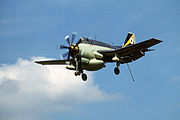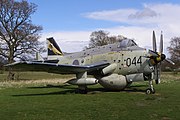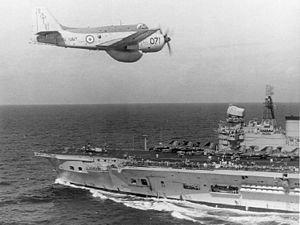| Gannet AEW.3 | |
|---|---|
| Royal Navy Gannet AEW.3 overflies HMS Eagle | |
| Role | Airborne early warning aircraft |
| National origin | United Kingdom |
| Manufacturer | Fairey Aviation Company |
| Designer | H. E. Chaplin (Fairey Gannet) |
| First flight | 20 August 1958 |
| Introduction | August 1959 |
| Retired | 15 December 1978[note 1] |
| Primary user | Royal Navy |
| Produced | 1958-1963 |
| Number built | 44 |
| Developed from | Fairey Gannet |

No. 849 Squadron Gannet AEW.3 showing wing folding system.
The Fairey Gannet AEW.3 was a variant of the Fairey Gannet anti-submarine warfare aircraft intended to be used in the airborne early warning (AEW) role on aircraft carriers of the Royal Navy. It was introduced to service in 1959 to replace the obsolete Douglas Skyraider, and was intended as an interim solution until the planned introduction of a new, purpose built AEW platform for use on a new type of aircraft carrier. Neither the new aircraft carriers nor the new AEW aircraft were proceeded with, and the Gannet AEW remained in service until the last aircraft carrier that could operate it was retired.
Design and development[]
In the late 1950s, the Royal Navy operated the piston-engined Douglas Skyraider AEW aircraft off its aircraft carriers. However, the Skyraider was designed during the Second World War. It entered service with the RN in 1951 and was considered obsolete by the late 50s. As a consequence, the RN looked to its then standard anti-submarine aircraft, the Fairey Gannet, as a replacement.
The intention was to use the Gannet as a stop-gap measure prior to the acquisition of a new, purpose built system intended to be used on the planned new generation of aircraft carriers. As a consequence, it was intended to undertake as little in the way of modification as possible - the AN/APS-20 radar[1] from the Skyraider would be mounted in a radome under the fuselage of an ordinary Gannet AS.1, with the associated electronics and space for two operators inside.[2] However, the size of the radome meant that the existing airframe was too close to the ground to accommodate the radar, and so a significant modification to the fuselage was required. This involved removing the observer's cockpits and creating a new cabin within the fuselage; this was accessed via a pair of hatches next to the trailing edge of the wing, which also meant that the exhausts had to be moved from this position to the leading edge; increasing the total area of the vertical stabiliser to compensate for the instability caused by the radome; and extending the length of the undercarriage to increase the clearance for the radome, which consequently increased the aircraft's overall height by 3 ft (1 m), and gave the aircraft a more level stance than the anti-submarine version.[2]
<templatestyles src="Template:Gallery/styles.css"></templatestyles>
- Standard and Airborne Early Warning versions compared
The prototype Gannet AEW.3 first flew in August 1958, with carrier trials taking place using HMS Centaur in November, and the first production aircraft delivered in December. By August 1959, 700G Naval Air Squadron was formed as the Trials Unit for the new Gannet. This unit put the aircraft through an intensive test programme to make it ready for operation service, a process that lasted until January 1960, at which point the unit was renamed as 'A' Flight of 849 Naval Air Squadron. 849A Flight was then declared operational and was embarked for the first time in HMS Ark Royal.[3] A total of 44 Gannets were ordered for the Royal Navy to replace the Skyraider.

Fairey Gannet AEW.3 landing
The Gannet AEW.3 was operated throughout its service by 849 NAS, which formed a total of four operational flights (A-D), each containing four AEW aircraft with a Gannet COD.4 for ship to shore communications.[4][5] These flights were regularly deployed from the large aircraft carriers then in service with the Royal Navy. Additionally, it was intended that the Gannet would initially be deployed from the planned CVA-01 aircraft carrier, until the entry into service of a purpose built AEW aircraft.[6] However, in the mid 1960s the British government brought in a series of defence cuts that led to the new carriers and their AEW aircraft being cancelled, and the phased withdrawal of fixed wing aviation in the Royal Navy. 849C Flight was disbanded in 1966 following the reduction of the carrier fleet to four ships (Ark Royal, Eagle, Hermes and Victorious). Subsequent carrier withdrawals led to the disbanding of 'A' Flight in 1970 and 'D' Flight in 1972.[4] The final operational Gannets were operated by 'B' Flight aboard Ark Royal following that ship's major refit and recommissioning in 1970.[7] The Gannet continued in service until the final decommissioning of Ark Royal in 1978 - a Gannet of 849B Flight was the last aircraft to be recovered by the ship on Saturday 18 November 1978.[8] The withdrawal of Ark Royal meant that there was no longer a platform available in the Royal Navy to operate the Gannet, and hence 849 Naval Air Squadron was disbanded in December 1978, leaving the Royal Navy without embedded airborne early warning.
AEW Mk. 7[]

Drawing of proposed Gannet AEW7
The AN/APS-20 radar was initially developed during the Second World War and had significant limitations to its capability, in terms of its performance at low level over water such that it had difficulty differentiating between sea clutter and actual targets, and short-range.[9] As a consequence, there were attempts to develop an updated AEW system for use on Royal Navy carriers, one of which was a proposed version of the Gannet, which would have become the AEW Mk. 7. The ventral radome containing the AN/APS-20 radar would have been replaced with a dorsal rotating dome (rotodome), similar to that used on the US Northrop Grumman E-2 Hawkeye (possibly to contain a version of the AN/APS-125 pulse-doppler radar). The size of the rotodome, and its position would have meant the single tailfin being substituted by a twin tail arrangement.[10] In the end, this proposal was not proceeded with.
[]
The phased withdrawal of the Gannet AEW, as part of the draw-down of fixed wing aviation in the Fleet Air Arm, led to a need for the Royal Air Force to take over the provision of Airborne Early Warning for the UK Air Defence Region. As an interim solution until a purpose built system could be procured, the radar and electronic systems from redundant Gannets were fitted to similarly redundant Avro Shackletons; the Shackleton was a maritime patrol aircraft then in the process of being replaced.[11] However, this still meant that the Royal Navy, then in the process of introducing a new type of small aircraft carrier incapable of operating conventional fixed-wing aircraft, lacked an embedded AEW platform that could be used as part of the carrier task group. This lack of organic AEW capability following the withdrawal of the Gannet was seen as misguided, particularly following the experience of the Falklands War, in which the Royal Navy lost four ships due to the Task Force being reliant on shipborne air search. As a consequence, the Westland Sea King helicopter was modified to incorporate the Searchwater radar system for use in the AEW role from the Invincible class.
Operational history[]
The Royal Navy developed its tactics in regards to airborne early warning using the Skyraider, and evolved them with the increased capabilities of the Gannet, in that aircraft had observers trained to interpret the information coming in from the onboard radar, and use it to control either the combat air patrol to intercept incoming strike aircraft, or alternatively direct its own aircraft to strike and attack a target.[12]
However, due to the quality of the equipment, the Gannet had limited command and control capability, built as it was around the AN/APS-20 S-Band search radar and AN/APX-7 IFF set,[13] connected to the AN/ART-28 Bellhop datalink.[14] The datalink would transmit the information received through the Gannet's onboard systems to the operations room on the aircraft carrier (or whichever ship was charged with directing the Gannet's operations), which would then act accordingly to any threat presented. However, the Gannet had no on board processing equipment, which meant that the observers had to interpret the raw radar signal.[15]
The Gannet had a three person crew, consisting of the pilot, located in the cockpit at the front of the aircraft, and a pair of observers in the cabin in the fuselage, accessible via a hatch next to the trailing edge of the wing. The aircraft had a typical endurance of 5–6 hours and a maximum altitude of 25,000 ft (7,600 m). The Gannet tended to cruise on just one engine of the Double Mamba powerplant; alternating between the two engines every half an hour.[16]
The sole operational Gannet squadron, 849 NAS had over the course of its time operating the aircraft a total of four operational flights plus the HQ flight. The HQ flight was stationed at three Fleet Air Arm air stations over the period of Gannet operation, while the majority of the operational flights were assigned to more than one aircraft carrier over the course of the Fleet Air Arm's use of the aircraft, with five RN carriers operating Gannet AEW flights.[12][17]
- HQ Flight - RNAS Culdrose (1960-1965); RNAS Brawdy (1965-1970); RNAS Lossiemouth (1970-1978)
- A Flight - HMS Ark Royal (1960); HMS Centaur (1961-1963); HMS Victorious (1963-1967); HMS Hermes (1968-1970)
- B Flight - HMS Victorious (1960-1962); HMS Hermes (1962-1967); HMS Ark Royal (1970-1978)
- C Flight - HMS Hermes (1960-1962); HMS Ark Royal (1962-1966)
- D Flight - HMS Eagle (1964-1971)
Variants[]
- Gannet AEW.3
- Standard AEW version, developed from the anti-submarine version; entered service in 1960, 44 built
- Gannet AEW.7
- Proposed update with new dorsal rotodome similar to that used on the Grumman E-2 Hawkeye, radar and electronic systems and twin tail assembly; never produced
Production[]
All 44 Gannet AEW.3s were built at the Fairey factory at Hayes; the prototype and first two production aircraft were then transported by road to RAF Northolt for their first flight. The remainder of the aircraft first flew at White Waltham Airfield.[18] One prototype (serial number XJ440) to be built at Hayes was ordered on 14 December 1954 against specification AEW.154D and first flown at RAF Northolt on 20 August 1958.[18] The production aircraft were ordered as specification AEW.154P in three separate batches:
- 31 ordered 25 February 1956; first aircraft flown from RAF Northolt on 2 December 1958.[18]
- 9 ordered 7 November 1959; first aircraft flown on 19 July 1961.[18]
- 3 ordered 17 February 1961; first aircraft flown on 19 February 1963.[18]
The final AEW.3 built was delivered to the Royal Navy on 6 June 1963.[18]
Operators[]
- Fleet Air Arm
- 700G Naval Air Squadron - intensive trials unit
- 849 Naval Air Squadron - sole operational squadron; provided flights of 3-4 aircraft to carrier air groups
Survivors[]
The majority of Royal Navy Gannets were scrapped following withdrawal. The drawdown of the Gannet force in the late 1960s and early 1970s however led to a significant amount of electronic equipment being removed from the Gannet airframes for installation in Avro Shackleton aircraft of the Royal Air Force, which allowed the RAF to undertake its own AEW operations.[4] In addition, a handful continued flying operations in the hands of civilian operators into the 1980s - one was used by Hamilton Standard in the United States for propeller vibration trials, while another was used by Dowty Rotol for propeller development purposes. In addition, a further AEW3 was used as a private display aircraft at airshows until the late 1980s.[2] As of 2012, one aircraft (XL500 civil registered as G-KAEW), which was once flown by Prince Charles, was undergoing comprehensive restoration to airworthy condition by Hunter Flying.[19][20]

Gannet AEW.3 XL472 at Gatwick Aviation Museum
- Germany
- Gannet AEW.3 XL450, is displayed at the Flugausstellung Hermeskeil in Germany[20]
- United Kingdom
Five aircraft are on display:
- Gannet AEW.3 XL472, Gatwick Aviation Museum, Surrey, England[20]
- Gannet AEW.3 XL502 at Yorkshire Air Museum, England[20]
- Gannet AEW.3 XL503 at the Fleet Air Arm Museum, Yeovilton[20]
- Gannet AEW.3 XP226 at Newark Air Museum, England[citation needed]
- Gannet AEW.3 XL497 at Dumfries And Galloway Aviation Museum, Scotland[citation needed]
- United States
- Gannet AEW.3 XL482 is displayed at the Pima Air Museum, Arizona[20]
Specifications[]
Data from British Naval Aircraft since 1912 [21]
General characteristics
- Crew: 3
- Length: 44 ft (13.41 m)
- Wingspan: 54 ft 4 in (16.57 m)
- Height: 16 ft 10 in (5.13 m)
- Wing area: 490 ft² (45.5 m²)
- Loaded weight: 25,000 lb (11,400 kg)
- Powerplant: 1 × Armstrong Siddeley Double Mamba ASMD 4 turboprop, 3,875 ehp (2,890 kW)
- Propellers: 2 contra-rotating 4-bladed
Performance
- Maximum speed: 250 mph (217 kn, 402 km/h)
- Range: 700 mi (609 nmi, 1,127 km)
- Endurance: 5-6 hours
- Service ceiling: 25,000 ft (7,600 m)
Armament
None
Avionics
See also[]
- Fairey Gannet
- Douglas AD-4W Skyraider
- Grumman E-1 Tracer
- Hawker Siddeley P.139B
- List of aircraft of the Fleet Air Arm
Notes[]
- ↑ 849 Naval Air Squadron flying Gannet COD.4 aircraft from Ark Royal and RAF Lossiemouth
References[]
Citations[]
- ↑ Andrea, Parsch (4 June 2007). "AN/APR to AN/APS - Equipment Listing". DesignationSystems.Net. http://www.designation-systems.net/usmilav/jetds/an-apr2aps.html#_APS. Retrieved 5 April 2011.
- ↑ 2.0 2.1 2.2 "Fairey Gannet History". Thunder and Lighnings. http://www.thunder-and-lightnings.co.uk/gannet/history.php. Retrieved 27 August 2012.
- ↑ "Gannet AEW.3s join the Fleet". Iliffe & Sons. 11 March 1960. pp. 343–344. http://www.flightglobal.com/pdfarchive/view/1960/1960%20-%200343.html. Retrieved 28 August 2012.
- ↑ 4.0 4.1 4.2 "Fairey Gannet AEW3". The Spyflight Website. http://www.spyflight.co.uk/gannet.htm. Retrieved 28 August 2012.
- ↑ "Fleet air Arm Gannet squadrons". Aeroplane Naval Aircraft Archive. http://www.condor49ers.org.uk/gannet.htm. Retrieved 28 August 2012.
- ↑ Richard Beedall (18 May 2011). "AEW and COD aircraft". CVA-01 Queen Elizabeth class. Navy Matters. http://navy-matters.beedall.com/cva01.htm. Retrieved 28 August 2012.
- ↑ Commissioning book HMS Ark Royal 1970-1973. HMS Ark Royal. 1973. pp. 60–64. http://www.axfordsabode.org.uk/pdf-docs/arkroy51.pdf. Retrieved 28 August 2012.
- ↑ HMS Ark Royal 1976-1978 - the Last Commission. HMS Ark Royal. 1978. pp. 63. http://www.axfordsabode.org.uk/pdf-docs/arkroy27.pdf. Retrieved 28 August 2012.
- ↑ Pettipas, Leo (June 2008). "The Grumman (Eastern) TBM-3W2 "Guppy" Avenger in the Royal Canadian Navy". Jerry Proc. http://jproc.ca/rrp/rrp3/avenger_guppy_3w2.html. Retrieved 30 August 2012.
- ↑ Gibson, Chris (2011). The Admiralty and AEW: Royal Navy Airborne Early Warning Projects. Blue Envoy Press. p. 22. ISBN 978-0956195128.
- ↑ "RAF airborne early warning plans". 1970. pp. 65. http://www.flightglobal.com/pdfarchive/view/1970/1970%20-%200087.html. Retrieved 8 October 2012.
- ↑ 12.0 12.1 Hobbs, David (1987). Aircraft of the Royal Navy since 1945. Liskeard: Maritime Books. p. 30. ISBN 0907771068.
- ↑ "AN/APX - Airborne Identification Radars". AN/APT to AN/APY - Equipment Listing. Designation systems.net. http://www.designation-systems.net/usmilav/jetds/an-apt2apy.html#_APX. Retrieved 29 August 2012.
- ↑ "Radar and Electronic Warfare". United Kingdom Aerospace and Weapons Projects. skomer.u-net.com. http://www.skomer.u-net.com/projects/radar.htm. Retrieved 29 August 2012.
- ↑ "Reconnaissance" (in English). 06/10/12.
- ↑ Polmar, Norman (2007). Aircraft Carriers: A History of Carrier Aviation and Its Influence on World Events Volume II 1946-2005. Washington DC: Potomac Books. p. 185. ISBN 9781574886634. http://books.google.co.uk/books?id=BNAXHkfMs5wC&lpg=PA185&ots=qHUBPylvCO&dq=fairey%20gannet%20AEW%20operations&pg=PA185#v=onepage&q=fairey%20gannet%20AEW%20operations&f=false. Retrieved 29 August 2012.
- ↑ Walton, Alex (30 December 1999). "Royal Navy Aircraft Carriers Part 3 1950 - 2000". Archived from the original on 30 June 2012. http://archive.is/SNSW. Retrieved 10 October 2012.[dead link]
- ↑ 18.0 18.1 18.2 18.3 18.4 18.5 18.6 Sturtivant 2004, pp 324-337
- ↑ "Prince of Wales’s Gannet to fly in Wales". Aeroplane Monthly. 10 April 2012. http://www.aeroplanemonthly.com/news/latest-news/388-prince-of-waless-gannet-to-fly-in-wales. Retrieved 30 August 2012.
- ↑ 20.0 20.1 20.2 20.3 20.4 20.5 "UK Military Aircraft Serial Allocations: XL". UK Serials Resource Centre. http://www.ukserials.com/results.php?serial=XL#. Retrieved 4 April 2011.
Bibliography[]
- Gibson, Chris. The Admiralty and AEW: Royal Navy Airborne Early Warning Projects. Blue Envoy Press, 2011. ISBN 978-0956195128.
- Hobbs, David. Aircraft of the Royal Navy since 1945. Martime Books, 1987. ISBN 0907771068
- Polmar, Norman. Aircraft Carriers: A History of Carrier Aviation and Its Influence on World Events Volume II 1946-2005. Potomac Books, 2007. ISBN 9781574886634.
- Sturtivant, Ray Fleet Air Arm Fixed-Wing Aircraft since 1946. Air-Britain, 2004. ISBN 0-85130 283 1
- Thetford, Owen. British Naval Aircraft Since 1912. London: Putnam, 1978. ISBN 0-370-30021-1.
- "Fairey Gannet" Flight 29 August 1958 page 315
External links[]
| Wikimedia Commons has media related to Fairey Gannet AEW.3. |
The original article can be found at Fairey Gannet AEW.3 and the edit history here.



